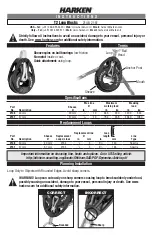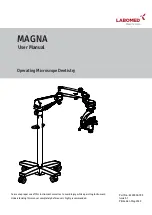
30
'ICGA' for pure indocyanine green angiography, or 'FA&ICGA' for simultaneous fluo-
rescein/indocyanine green angiography.
(3)
Set the parameters for image acquisition as follows:
•
sensitivity of the detector to 80%
•
For pure indocyanine green angiography:
•
ICGA laser intensity to 100 %
•
For simultaneous fluorescein/indocyanine green angiography:
•
ICGA laser intensity to 50% - 75 %
Note:
During simultaneous fluorescein/indocyanine green angiography, the intensity of the
indocyanine green fluorescence is usually much brighter for the first 1 to 2 minutes
than the fluorescein. To get the same brightness for both dyes we, therefore, recom-
mend reducing the intensity of the infrared light for the early phase to 50% - 75%.
After 1 or two minutes the laser intensity should be reset to maximum (100 %).
(4) Inject the fluorescent dye(s). Press the 'Inj’ button on the touch panel during or immediately
after injection to start the clocks(s) for the injection time. Please note that the clock(s) will
always be started according to the selected acquisition mode.
(5) Select ‘Single’ or ‘T-Sequence’ on the touch panel if a automated image acquisition of a com-
plete sequence is desired.
(6) Ask the patient not to move. Watch the image on the screen. As soon as you see the first fluo-
rescence, press the 'Acquire' button on the control panel to start the image acquisition.
Note:
The Heidelberg Retina Angiograph includes an internal cyclic buffer for live images
acquired during the last 2 seconds (for setting the length of the cyclic buffer, see
Chapter 4.3.1). These images are stored as soon as you hit the 'Acquire' button to ini-
tiate the acquisition of a time resolved image series. This ensures that the images of
the last 2 seconds are stored before starting the time series.
(7) The image intensity will vary quickly during the inlet phase of the dye. Watch the image on
the screen. Make sure the camera remains adjusted to the eye and the image brightness does
not approach saturation. Overexposure causes white areas in the image. If necessary, readjust
the image brightness using the 'sensitivity' control on the touch panel.
(8) Watch the number of acquired images in the bottom screen section. An acquisition of a T-
Sequence can be stopped using the 'Stop' button on the touch panel.
(9) Immediately after interrupting the series acquisition, you are able to acquire single images
using the 'Acquire' button again.
(10) Now, acquire individual images by pressing the ‘Acquire’ button on the control panel or the
foot switch. Press the ‘More’ button on the touch panel to change between ‘High resolution’
and ‘High speed’ acquisition if required.
(11) Press the 'freeze' button and select the 'Save Images' menu item to store the acquired images
to hard disk. After the storage procedure, the main memory of the PC is available for acquisi-
tion and you are able to acquire more images.
(12) To acquire a layered three-dimensional image, press on the ‘T-Sequence’ button twice and
select ‘Z-Sequence’ and adjust the scan depth to an appropriate value. The right setting de-
pends on the observed structure. A typical setting is 5 to 6 mm. Now press the 'Acquire' but-
Summary of Contents for HRA 2
Page 3: ...Heidelberg Retina Angiograph 2 HRA 2 Operation Manual ...
Page 4: ......
















































